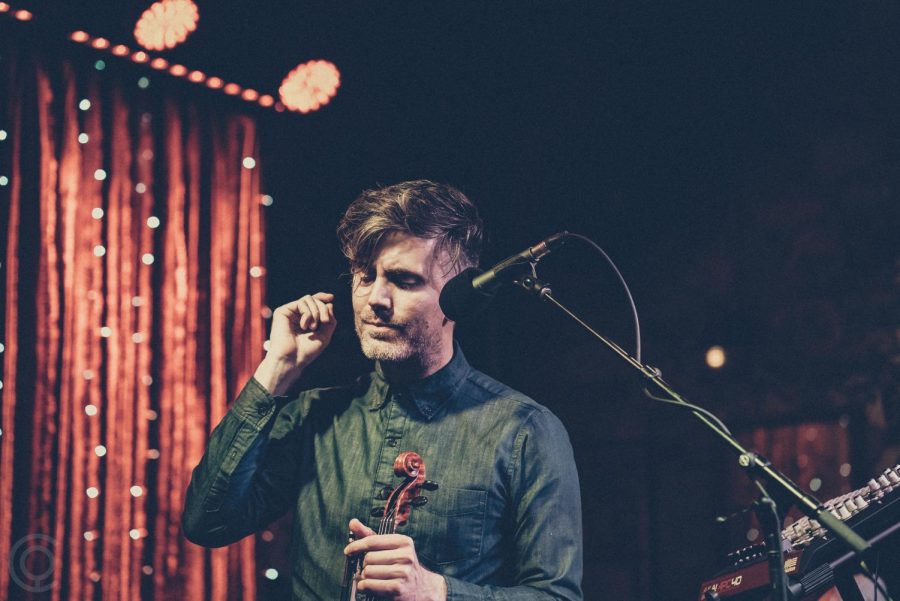‘S-Town’ original score shines behind narrative
“S-Town” composer and musician Daniel Hart combines classical violin with hip-hop in the podcast soundtrack. He lives in Los Angeles and his band Dark Rooms is working on its second album.
April 17, 2017
Classical music riffs mix with hip-hop drum beats, emphasizing each twist and turn of the Southern Gothic story told in the podcast “S-Town.” The podcast also features The Zombies’ 1968 song, “A Rose for Emily,” named after the William Faulkner short story.
“S-Town” is the latest work from Ira Glass and Julie Snyder’s Serial Productions, which produces “Serial” and “This American Life.” It has been the No. 1 podcast on iTunes since the March 28 release of all seven episodes simultaneously—a new approach for Serial Productions.
In “S-Town,” interview subject John B. McLemore and host Brian Reed take the audience on an unpredictable yet fortifying journey through Alabama’s Bibb County to understand the isolation that led to McLemore’s suicide and share a view of the South not usually discussed in the media.
Daniel Hart’s score follows the haunting developments in the story. Hart said Glass reached out to him to create the music in 2016 after the reporting was completed. Hart, who has recorded with bands such as St. Vincent, has scored more than a dozen feature films including Disney’s “Pete’s Dragon,” Fox’s TV show “The Exorcist” and the Natalie Portman-produced documentary “Eating Animals,” began writing one song a day for the podcast soundtrack. He started with the theme song “Bibb County,” which he said was like his audition clip to the producers. The music can be purchased on iTunes or streamed on either the podcast’s site or Hart’s site.
“The kind of music they wanted for the show was something I enjoy making, comes natural to me and covers my background,” Hart said, who is a classically trained violinist, professional musician and film composer living in Los Angeles.
Hart said he had more freedom with the “S-Town” soundtrack compared to his cinematic work and was able to explore hip-hop drum beats with classical music. The combination is present throughout the podcast but becomes more prominent when the story takes a sudden turn after the third episode.
Aside from having artistic freedom and blending different styles of music and instruments, Hart said his goal was to make sure it spoke to the story’s setting and characters, and not play on stereotypes about the South, particularly recent political ones made in the tense political climate of this era.
“Doing the music for ‘S-Town’ was more than just creating music for a good story with people I admire and like working with,” he said. “Especially in a time of oversimplified and often exaggerated, headline-grabbing lives we live, [through the music] I am searching for the complexity I know to be actual human existence.”
The Dallas, Texas native has lived more than half his life in the South, including a summer in Alabama, so he knows it is important to convey the complexity of life everywhere. His goal was achieved when he received a message from a listener of the podcast who lives close to Bibb County.
“[The man from Bibb County] said he thought the music really captured the essence of the part of the country where he lives, and that was exactly what I had hoped to do,” he said. “That meant a lot to me.”
Mark Bramhill, a senior visual and dramatic arts major at Rice University in Houston, Texas, listened to “S-Town” when it was released and was drawn to the music because of its cinematic treatment and said he appreciated the original scoring. Bramhill, who also plays the banjo, applauds Hart for not pandering to stereotypes of the South by adding twangy bluegrass or folky tunes.
Bramhill, who interned with NPR’s “Planet Money” and now has his own self-produced podcast “Welcome to Macintosh,” said the music helped grab his attention and better understand the story and its characters.
“It truly feels [part of] the story and affects the way the story is told and how you receive it,” Bramhill said. “It makes it something [that] adds themes of characters, then in some cases are mutated or changed. It also brings you in emotionally and systematically without being too on the nose.”
He mentioned that the repetition heard in the opening and closing music of radio shows give the audience an audio cue not many listeners pay attention to, but Hart’s intro music was captivating and harnessed the story.
NPR Music, “All Songs Considered” and “Pop Culture Happy Hour” co-host and co-creator Stephen Thompson said in an April 5 interview with The Chronicle that “S-Town’s” new approach of releasing all the episodes at once garnered massive attention and shows promise for the podcast world and those working in it.
“There is this huge universe of potential listeners and podcasting still only reaches a fraction of those people,” Thompson said. “When you have a show like ‘S-Town’—that was downloaded 10 million times in first couple of days—to us that is music to our ears because that means more people are taking an interest in podcasting.”
Hart said he is blown away by the praise the podcast is receiving and is proud of the whole team and story structure that has captivated listeners.
“I am so happy with what I did. It’s not always the case,” he said. “The freedom [Snyder] gave me to just write music meant that [it could] stand on its own, which was useful for me and hopefully them.”








